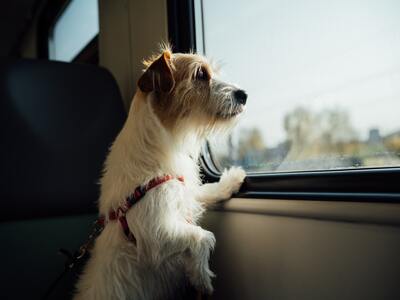
Moving is often stressful for dogs. They face a sudden change of environment and, no matter how much we want to, we can’t explain the change to them. However, there are many steps that you can take to ease the stress.
One important step is maintaining their routine. If you normally walk your dog at lunchtime for half an hour, it’s important to continue doing whenever possible during the move. The same goes for feeding – try to feed your dog from the same bowl, in the same place, and at the same time despite the move. This demonstrates to your dog that, while the scenery around them is changing, life as they know it will continue.
Another way to keep your dog calm is to choose a room where your dog can feel safe and keeping them in there. A house mid-move can be chaotic with boxes, strange people, and constant trips back-and-forth. The last thing that anybody needs while moving with a dog is a nervous animal underfoot, and your dog will likely be far happier in another room with the door closed. Set up a room for your dog’s comfort by including their bed and some of their favourite toys – and be sure to check in frequently. If there’s a TV or radio in the room, putting it on quietly can provide some calming background noise and distract from the sounds coming from elsewhere in the house.
Alternatively, you could send your dog to spend the day with a trusted neighbour or friend. This keeps them out of the way and ensures that they’ll be distracted and well taken care of on the busiest day of the move.
Moving with a dog can be stressful or anxiety-provoking, but dogs adjust quickly in the right conditions. In the short-term, it’s common for dogs to change their behaviour in unpredictable ways. They may begin chewing things they’re not supposed to, barking more often, digging in the garden or having accidents indoors. Fortunately, these behaviours will quickly disappear as your dog becomes accustomed to their new home.
While the move may be challenging in the short-term, dogs are adaptable and will quickly become accustomed to their new home. The effects of moving are temporary, and before long you should have your canine companion back in full form.
The question of how to settle a dog into a new house varies, as every dog is unique. In general, you want to show your dog that many things have remained the same, that the new house is safe, and that you still love them.
Introduce your dog to your new home room by room, beginning with the room where your dog’s bed or crate will be. Set up the sleeping area with existing toys, blankets and towels – try to avoid the temptation to toss out the dirty old dog towels when you move to your nice new place, as the familiar scents in them will be reassuring to your pet.
Allow your dog to explore the full extent of your new home, including any outdoor space. Even small dogs often imagine themselves as the brave family guard dog, so let them sniff around their new environment to assure them that it’s safe. It’s worth following your dog as it does its initial exploration, however, in case it decides to mark its new territory.
Be sure to apply the same puppy-proofing and dog safety measures in your new home as you once did in your old home. It’s easy to forget that certain plants can be dangerous to dogs, or that plugs and wires may look like chew toys to canine eyes. If your dog digs, be sure to check any outdoor space and apply additional chicken wire or fencing to ensure they can’t get out.
The final and most important step of moving with a dog is ensuring that your dog receives as much love and attention as it’s used to. There may be lots to do, but it’s important to spend time with your pet, play with it, walk it and spend time with it so that it knows that the centre of its world – you – didn’t change in the move.

When you first introduce your pet, there’s a chance you’ll have to deal with your dog freaking out in the new home. If this happens, remember that your dog takes its cues from you – the calmer you are, the calmer your pet will be. Speak to your dog in a calm voice and bring its attention to familiar items from the old house, like its bed, towel and toys. Try to distract your dog with play or by going for a long walk or run in a local park. Just like a toddler having a tantrum, your dog will soon move on, especially if you remain calm.
After moving with a dog, the time that it takes them to settle varies significantly. Some may be back to normal within a few days, while others may take weeks. Try to be understanding – your dog’s entire world was just overturned with no explanation – and know that any misbehaviour is the product of your dog’s distress rather than an attempt to irritate you. Ultimately, dogs aren’t known for their long memories, so it won’t be too long before your dog is back to wagging its tail as normal.
One great way to reduce the stress of moving day is to use self storage while you’re moving home. This saves you from having to move everything in one go – and the more gradual change could be easier for your dog to adjust to.